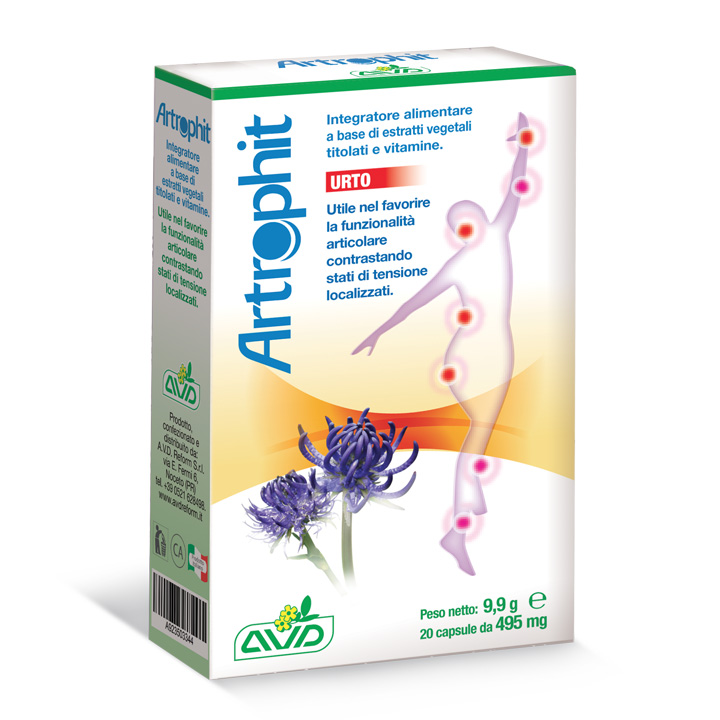
Useful in the treatment of inflammatory and painful conditions of the osteoarticular and muscular apparatus
HEALTH BENEFITS:
Food supplement based on titrated plant extracts and vitamins, useful in the treatment of inflammatory and acute painful conditions of the osteoarticular and muscular apparatus.
PROPERTIES:
Each capsule of Artrophit Urto contains 100 mg of IridoforceTM, a Harpagophytum Procumbens extract (titrated to a minimum of 20% in harpagoside), obtained through a patented extraction process that guarantees a high degree of purity and concentration. Studies have shown that the gluco-iridoid harpagoside contained in IridoForceTM inhibits oxygenase type 2 (COX-2), an essential enzyme in the synthesis of prostaglandin E2 (PGE2), which plays an important role in the inflammatory process, thus reducing phlogosis and consequent painful events. In addition, IridoForceTM significantly stimulates the synthesis of hyaluronic acid, promoting the formation of a new extracellular matrix (ECM). The addition of titrated extracts of Salix and Parthenium enhances its action, making the product particularly useful in the treatment of conditions affecting the osteoarticular and muscular systems. Vitamin B2 and B6, essential for nerve health, complete the effect of the product, while the shell of the DRcapsTM acid-resistant vegetable capsules protects the active ingredients from the action of gastric juices, helping to maintain their properties unchanged.
INGREDIENTS:
- IridoforceTM (Devil’s claw) dry extract, titrated at 20% in harpagoside
- Parthenium dry extract, titrated at 0.8% in parthenolide
- Salix dry extract, titrated at 30% in salicin
- Vitamin B6 (pyridoxine)
- Vitamin B2 (riboflavin)
HOW TO USE:
1 capsule twice a day, preferably after meals
PACK:
20 capsules
DRcapsTM acid-resistant vegetable capsules
NOTES:
store in a cool, dry place
| AVERAGE INGREDIENT CONTENT | PER 2 CAPSULES | per 100 gr |
| Iridoforce™ | 200 mg | |
| Harpagoside content | 40 mg | |
| Parthenium | 200 mg | |
| Parthenolide content | 1,6 mg | |
| Salix dry extract | 200 mg | |
| Salicin content | 60 mg | |
| Vitamin B6 | 3 mg | 214 % |
| Vitamin B2 | 2,4 mg | 171 % |
BIBLIOGRAPHY:
- CHRUBASIK S., et al., Comparison of outcome measures during treatment with the proprietary Harpagophytum extract Doloteffin in patients with pain in the lower back, knee or hip. Phytomedicine, 9, 181-194, 2002.
- WEGENER T, Devil’s claw : from African traditional remedy to modern analgesic and anti-inflammatory. 2000, Herbalgram, 50, 47-54
- CHRUBASIK S, Traditional herbal therapy for the treat-ment of rheumatic pain : preparations from Devil’s claw and stinging nettle. SIG on Rheumatic pain newsletter, 1997
- The effectiveness and economy of Harpagophytum extract in acute low back pain : first results of a therapeutic cohort study.Forsch Komplementärmed, 4, 332-336, 1997
- FIEBICH BL, Heinrich M, Hiller KO, Kammerer N, Inhibition of TNF-A synthesis in LPS-stimulated primary human monocytes by Harpagophytum extract SteiHap 69. Phytomedicine, 2001, 8, 28-30
- JANG M.H., et al., Harpagophytum procumbens sup-presses lipopolysaccharidestimulated expressions of cyclooxy-genase-2 and inducible nitric oxide synthase in fibroblast cell line L929. J. Pharmacol. Sci., 2003. 93(3): p. 367-371
- LEBLAN D, Chantre P, Fournié B, L’harpagophyton dans le traitement de la gonarthrose et de la coxarthrose. Résultats à quatre mois d’une étude prospective multicentrique, contrôlée en double aveugle, versus diacerhein. Rev. Rhum. Ed Fr, 2000, 67, 634-640
- WEGENER T, Lüpke NP, Treatment of patients with Arthrosis of hip or knee with an aqueous extract of Devil’s claw (Harpagophytum procumbens DC). Phytotherapy research, 17, 1165-1172, 2003
- Handa S.S. et al. Plants with antiinflammatory activity. Fitoterapia, LXIII, 1, 3, 1992
- Chrubasik S. et al. Treatment of rheumatic pain with herbal medicine in Europe. Pain Digest Vol: 8, 231-236, 1998
- Ernst E. et al. Phyto-anti-inflammatories: A systemic review of randomized, placebo- controlled, double-blind trials. Rheumatic Disease Clinics of North America Vol: 26, 13, 2000
- Chrubasik S. et al. Treatment of low back pain exacerbations with willow bark extract: a randomized double-blind study. Am. J. Med. 109, 9-14, 2000
- Schmid B. et al. Efficacy and tolerability of a standardized willow bark extract in patients with osteoarthritis: Randomized placebo-controlled, double blind clinical trial. Phytotherapy Research Vol: 15, 344-350, 2001
- Chrubasik E. et al. Salicin and Treatment of Rheumatic Diseases. J. Rheumatol. 30(5):1125, 2003
- Chrubasik E. Et al. Influence of willow bark extract on cyclooxygenase activity and on tumor necrosis factor or interleukin 1 release in vitro and ex vivo. Clin Pharmacol Ther. 73(3):272-4, 2003
- Biegert C. Et al. Efficacy and safety of willow bark extract in the treatment of osteoarthritis and rheumatoid arthritis: results of 2 randomized double-blind controlled trials. J Rheumatol. 31(11):2121-30, 2004
- Khayyal M.T. et al. Mechanisms involved in the anti-inflammatory effect of a standardized willow bark extract. Arzneimittelforschung. 2005;55(11):677-87, 2005
- Murphy J.J. et al. Randomized double blind placebo controlled trial of feverfew in migraine prevention. Lancet 2, 189-192, 1988
- Sumner H. et al. Inhibition of 5-lipoxygenase and cyclo-oxygenase in leukocytes by feverfew. Involvement of sesquiterpene lactones and other components Biochem. Pharmacol. 43, 2313-2320, 1992
- Williams C.A. et al. The flavonoids of Tanacetum parthenium and T. vulgare and their anti-inflammatory properties. Phytochemistry 51, 417-423, 1999
- Kwok B.H. et al. The anti-inflammatory natural product parthenolide from the medicinal herb Feverfew directly binds to and inhibits IkappaB kinase. Chem. Biol. 8, 759-766, 2001
- Gagnier J.J. et al. Harpagophytum procumbens for osteoarthritis and low back pain: a systematic review. BMC Complement Altern Med. 4(1):13, 2004.



